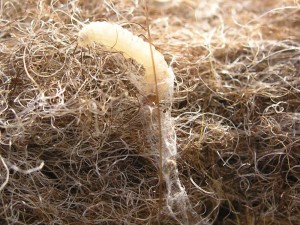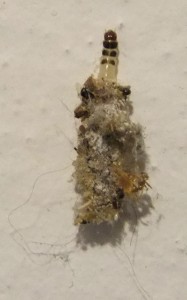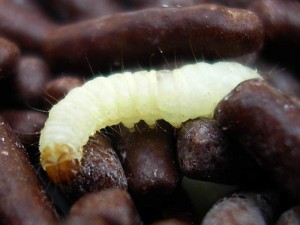Moth larvae are very small, especially during the period from when they hatch until they become adults, but as adults, they are more visible.
The size of adult larvae varies by species and can range from 6 to 20 mm. Most larvae, however, are between 7 and 13 mm in length.
The larvae are whitish or yellowish with dark heads and are often found on textiles or in food products.
Below are images of a clothes moth larvae, a case-bearing clothes moth larvae, and an Indian meal moth larvae. There is no image of a brown house moth larvae, but it closely resembles the Indian meal moth larvae.
Size, Food, Habitat, and Characteristics
In the table below, you will find the size, food, habitat, and characteristics of various moth larvae:
| Moth species | Image of the adult moth | The length of the fully developed larvae | Food | Typical habitats | Characteristics |
| Clothes moth | 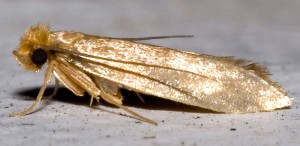 |
8 – 10 mm (normally) but up to 13 mm | Wool, silk, feathers and down, but also blended textiles and unclean textiles. | Textiles (especially clothing) in cabinets, drawers, bags, boxes, etc. and home textiles. | The larvae spins its pupa directly on the food source and feeds on it from there. The pupa consists of web, excrement and parts of the food source. |
| case-bearing clothes moth | 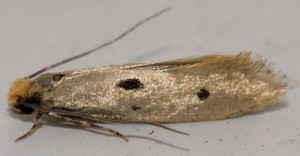 |
6 – 9 mm (in its cocoon) | Especially fur and feathers, but also other textiles and possibly also certain dry foods. | Textiles in cabinets, drawers, bags, boxes, etc. as well as home textiles and to some extent kitchen cabinets. | In the pupal stage, the larvae drags its pupa with it and tends to move upwards – it settles on the ceiling or walls, for example. The pupa is the same color as the food source. |
| Brown house moth | 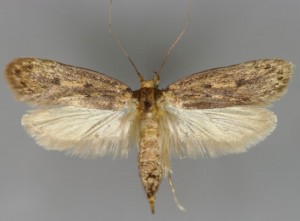 |
6 – 20 mm | Textiles, dry food, plant materials and certain animal materials. | Wardrobes, kitchen cabinets, utility rooms, garages, basements, attics, gardens and more. | The larvae are almost omnivorous, but in homes they often feed on organic materials such as textiles and food – often found in bird nests. |
| Indian meal moth | 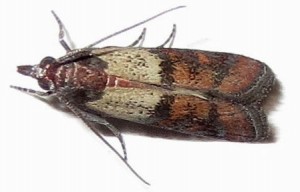 |
12 – 13 mm | Dry foods and certain plant materials. | Kitchen cabinets and other places where dry food is stored. | Hiding in food or in dark cracks, crevices, corners etc. around food. |
Moth Larvae in Clothes
As indicated in the table, larvae found in clothes can belong to the following moth species:
- Clothes moth (very likely)
- Fur moth (likely)
- Brown house moth (less likely)
Moth larvae usually attack clothing made of organic materials such as wool, silk, fur, feathers, etc. Clothes moths can also attack clothing made of synthetic or plant-based fabrics such as cotton, linen, hemp, etc.
Signs of moth larvae presence in clothes include:
- Small holes in the fabric
- Webbing on the clothes
- Droppings on the clothes
- larvae crawling on or inside the clothing
If you discover moth larvae in clothing or other textiles, they are most often clothes moth larvae, while larvae in fur are typically case-bearing clothes moth larvae. All moths prefer clothing stored in closets, drawers, bags, etc., which are rarely used.
Moth Larvae in Food
Moth larvae in food can belong to the following moth species:
- Indian meal moth (very likely)
- Brown house moth (likely)
- Case-bearing clothes moth (less likely)
Moth larvae generally attack dried foodstuffs such as cereals, grains, seeds, semolina, bulgur, rice, powdered milk, instant coffee, etc., but they can also attack tea, spices, tobacco, and more. Signs of moth larvae presence in food include:
- Webbing on the food
- Droppings on the food
- larvae crawling on or inside the food
- Food appears clumped, strange, or spoiled
When moth larvae infest food, they will eventually begin to move towards the surface of the food, making them visible. Therefore, it's important to inspect all dry food in your kitchen cupboards if you suspect moths.
Control
The control of both moths in clothing and food moths involves eliminating and removing all eggs, larvae, and adult moths.
For clothes moths, this can be done in four ways:
- Washing and drying
- Chemical cleaning
- Freezing (below -18°C for at least 2 days)
- Heating (above 50°C for at least 30 minutes)
Additionally, moth bags and clothes moth traps should be used (they also work against case-bearing clothes moths).
For food moths, control should consist of thorough cleaning and discarding all infested food products. You can also freeze or heat food items where the damage is minimal.
It's important to find out where the food moths originated. It could be the store, warehouse, producer, a neighbor, or your own home! Food moths should always be controlled at their source.
While it is possible to combat moths with insecticide, this is generally discouraged. It is only relevant in cases of severe infestations and should always be done in collaboration with a licensed pest control expert.
Prevention
Future infestations of clothes moths are best prevented by:
- Storage: Store all clothing and textiles that are rarely used in completely sealed plastic or paper bags (especially clothes and textiles made of organic materials).
- Moth bags and traps: Place moth bags in all closets and drawers containing clothes or other textiles (especially clothes and textiles made of organic materials). For preventing clothes moths, moth bags and clothes moth traps are recommended (they also work against case-bearing clothes moths), and for preventing food moths, Mediterranean flour moth traps are recommended.
You can also read more about the control and prevention of moths in the respective articles for each species:
Additionally, you can find an overview of 12 different moth species here.

